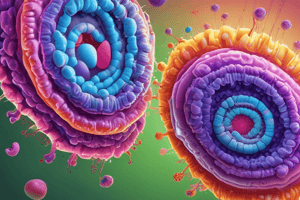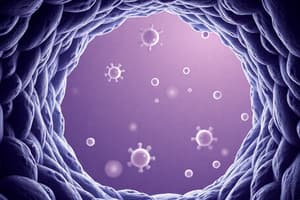Podcast
Questions and Answers
Which of the following scenarios exemplifies a pathogen entering a host via the parenteral route?
Which of the following scenarios exemplifies a pathogen entering a host via the parenteral route?
- Entry of a virus through the conjunctiva of the eye.
- Ingestion of contaminated food causing gastrointestinal distress.
- Transmission of bacteria through a mosquito bite. (correct)
- Inhalation of fungal spores leading to respiratory infection.
Why might some bacteria survive the acidic environment of the stomach?
Why might some bacteria survive the acidic environment of the stomach?
- They secrete a neutralizing buffer.
- Some bacteria, like _Vibrio cholerae_, possess mechanisms to withstand or neutralize stomach acid. (correct)
- They form endospores resistant to acid.
- They can penetrate the stomach lining directly.
Why is the number of microbes introduced to a host a critical factor in the development of disease?
Why is the number of microbes introduced to a host a critical factor in the development of disease?
- The host's immune system is equally effective regardless of the number of microbes introduced.
- The type of microbe is irrelevant as long as the quantity is high enough.
- The likelihood of disease increases with the number of microbes introduced, as a sufficient quantity is needed to overwhelm host defenses. (correct)
- A larger initial dose of microbes always guarantees a more severe disease outcome.
Which of the following best explains why unbroken skin is an effective barrier against most microbes?
Which of the following best explains why unbroken skin is an effective barrier against most microbes?
A bacterium has an ID50 of 50 cells when entering through a skin abrasion and an ID50 of 100,000 cells when ingested. Which statement is correct?
A bacterium has an ID50 of 50 cells when entering through a skin abrasion and an ID50 of 100,000 cells when ingested. Which statement is correct?
A pathogen adheres to host cells using surface molecules that bind to specific receptors. What are these surface molecules called?
A pathogen adheres to host cells using surface molecules that bind to specific receptors. What are these surface molecules called?
How do invasins facilitate the spread of a pathogen within a host?
How do invasins facilitate the spread of a pathogen within a host?
Which mechanism do bacteria use to protect themselves from host defenses while inside a host cell?
Which mechanism do bacteria use to protect themselves from host defenses while inside a host cell?
Why are exotoxins generally more potent than endotoxins?
Why are exotoxins generally more potent than endotoxins?
How does Clostridium tetani cause rigid paralysis?
How does Clostridium tetani cause rigid paralysis?
How do enterotoxins primarily affect the host?
How do enterotoxins primarily affect the host?
Why can antibiotic treatment sometimes worsen symptoms associated with endotoxins?
Why can antibiotic treatment sometimes worsen symptoms associated with endotoxins?
How do enveloped viruses evade host defenses?
How do enveloped viruses evade host defenses?
What are cytopathic effects (CPE) in the context of viral infections?
What are cytopathic effects (CPE) in the context of viral infections?
Which of the following is an example of a cytopathic effect observed in host cells infected by a virus?
Which of the following is an example of a cytopathic effect observed in host cells infected by a virus?
Which of the following is a characteristic of exotoxins but not endotoxins?
Which of the following is a characteristic of exotoxins but not endotoxins?
Which of the following is a true statement about the LD50?
Which of the following is a true statement about the LD50?
Why are toxoids effective in vaccines?
Why are toxoids effective in vaccines?
Which of the following enzymes is not an example of an extracellular enzyme?
Which of the following enzymes is not an example of an extracellular enzyme?
What disease does Clostridium botulinum cause?
What disease does Clostridium botulinum cause?
Flashcards
Respiratory Tract
Respiratory Tract
The most common portal of entry for microbes, where they are inhaled through the nose or mouth.
Gastrointestinal Tract
Gastrointestinal Tract
A route for microbes to enter the body via food or water.
Genitourinary Tract
Genitourinary Tract
A route for microbes to enter the body during sexual contact.
Parenteral Route
Parenteral Route
Signup and view all the flashcards
Adherence
Adherence
Signup and view all the flashcards
Invasiveness
Invasiveness
Signup and view all the flashcards
Extracellular Enzymes (Exoenzymes)
Extracellular Enzymes (Exoenzymes)
Signup and view all the flashcards
Invasins
Invasins
Signup and view all the flashcards
Toxin Definition
Toxin Definition
Signup and view all the flashcards
Toxoid
Toxoid
Signup and view all the flashcards
Exotoxins
Exotoxins
Signup and view all the flashcards
Neurotoxins
Neurotoxins
Signup and view all the flashcards
Enterotoxins
Enterotoxins
Signup and view all the flashcards
Cytotoxins
Cytotoxins
Signup and view all the flashcards
Endotoxins
Endotoxins
Signup and view all the flashcards
Cytopathic Effects (CPE)
Cytopathic Effects (CPE)
Signup and view all the flashcards
Infectious Dose (ID50)
Infectious Dose (ID50)
Signup and view all the flashcards
Lethal Dose (LD50)
Lethal Dose (LD50)
Signup and view all the flashcards
Study Notes
How Microorganisms Enter a Host
-
Germs must penetrate host defenses to damage tissues and cause disease
-
Mucous membranes are a common entry point
-
The respiratory tract is the most common portal of entry for microbes that are inhaled through the nose or mouth, like influenza and colds
-
The gastrointestinal tract is another entry for germs in food or water
-
Most are destroyed by stomach acid or bile, but some, like Vibrio cholerae, can survive
-
Sexually Transmitted Infections enter through the genitourinary tract
-
Conjunctiva, the membrane covering the eye, can be penetrated
-
Some pathogens require a broken mucous membrane, such as a cut or micro-abrasion, and others can penetrate unbroken membranes
-
Intact skin is impenetrable by most microbes
-
Some microbes can enter through hair follicles or wounds
-
Some fungi can grow directly on the skin without needing to enter through breaches
-
The parenteral route involves microbes being deposited directly into tissues when the skin or membranes are broken
-
For example, a tick bite can introduce bacteria, like Lyme Disease, or an intravenous injection with a contaminated syringe can introduce HIV
Number of Microbes Introduced
- If too few microbes enter the body, the immune system can easily fight them off and prevent disease
- The likelihood of disease increases with the number of microbes introduced
Infectious Dose
- The virulence of a microbe can be expressed numerically using the infectious dose
- ID50 is the amount of bacteria needed to cause disease in 50% of the population
- For Bacillus anthracis, the ID50 depends upon the route of entry
- 10-20 endospores via a cut in the skin
- 10,000 to 20,000 endospores via inhalation
- 250,000 to 1,000,000 endospores via ingestion
- The potency of a toxin is expressed as the lethal dose
- LD50 is the dose that kills 50% of the infected population
Mechanisms of Pathogenicity
-
Adherence involves surface molecules that allow a pathogen to stick to the surface
-
Pathogens often adhere to specific receptors on the host cell surface
-
Examples include fimbriae or glycocalyx of bacteria and viral proteins
-
Invasiveness is the ability of a pathogen to invade and multiply in healthy tissues
-
Two types of molecules promote invasiveness: extracellular enzymes and invasins
Extracellular Enzymes (Exoenzymes):
- These enzymes erode the surface of host cells and damage tissues, providing nutrients, and protection for microbes
- Specific Examples:
- Hemolysin destroys red blood cells
- Fibrinolysin degrades fibrin coats
- Collagenase degrades connective tissue
- Coagulase promotes blood clots around the bacterial cell
Invasins
- Surface proteins cause rearrangements of the host cell cytoskeleton, forcing the host cell to take in the bacterium, thus protecting the bacterial cell from host defenses
Bacterial Toxins
- A toxin is a poisonous substance produced by a microorganism
- A toxoid is an inactive toxin
- Toxoids can be used as vaccines
- For example, the DTaP vaccine contains diphtheria, pertussis, and tetanus toxoids
- Exotoxins are toxins secreted from the bacteria that are heat sensitive and can be extremely toxic
- Clostridium botulinum produces botulism toxin, where 1mg can kill 1,000,000 guinea pigs
Categories of Exotoxins:
- Neurotoxins interfere with nerve impulses
- Botulinum toxin, produced by Clostridium botulinum, causes flaccid paralysis by permanently relaxing muscles, eventually stopping the heart and breathing
- Tetanus toxin, produced by Clostridium tetani, causes rigid paralysis, resulting in uncontrollable muscle contractions (spasms) and lockjaw, with death usually due to spasms of the respiratory muscles
- Enterotoxins interfere with salt absorption in the small intestine
- These cause cells to pump out water to counteract the high salt concentration, resulting in watery diarrhea
- For example, Montezumas revenge (E. coli) and Cholera (Vibrio cholera)
- Cytotoxins kill cells by interfering with protein synthesis
- For example, diphtheria toxin causes respiratory illness
Endotoxins
- Are part of the outer membrane of gram-negative bacteria
- Lipopolysaccharide (LPS) does not cause problems when embedded in the membrane
- Endotoxin (LPS) is released when the bacterium dies, worsening symptoms
- Endotoxins can cause fever, hemorrhaging, and shock
- They are less potent than exotoxins
- For example, Salmonellosis (Salmonella enterica) is food poisoning due to millions of dead bacteria, where symptoms are caused by endotoxin
Comparing Endotoxins and Exotoxins
- Exotoxins:
- Proteins that are released outside of the cell
- Extremely toxic and often lethal
- Endotoxins:
- Lipopolysaccharides (LPS) only released when the bacteria dies
- Not as toxic and usually not lethal
Viral Infections:
- Viruses evade defenses by invading and growing inside of cells, making them inaccessible to the immune system
- Viruses may disguise themselves to look like their hosts
- For example, enveloped viruses can steal a membrane directly from their host
Cytopathic Effects (CPE):
- Visible effects of viral infection
- Disruption of cell processes
- For example, Herpes simplex virus stops host cell division
- Destruction of intracellular structures
- Formation of inclusion bodies from viral parts (capsomeres)
- Giant cell formation where several infected cells fuse to form one giant cell
- For example, colds
- Viral infection often results in host cell death
Studying That Suits You
Use AI to generate personalized quizzes and flashcards to suit your learning preferences.




